“Too Late to Leave”
I’m not sure I’ve ever experienced more stomach-clenching, bone-chilling words. Certainly not when they might have a direct impact on you or yours. That hard, cold piece of information is delivered by emergency services once the window of opportunity to evacuate a certain area in the approach of a bushfire has closed. The next line of the automated texts that are broadcast to all switched-on phones in the geographical radius reads: “Seek shelter as the fire arrives.”
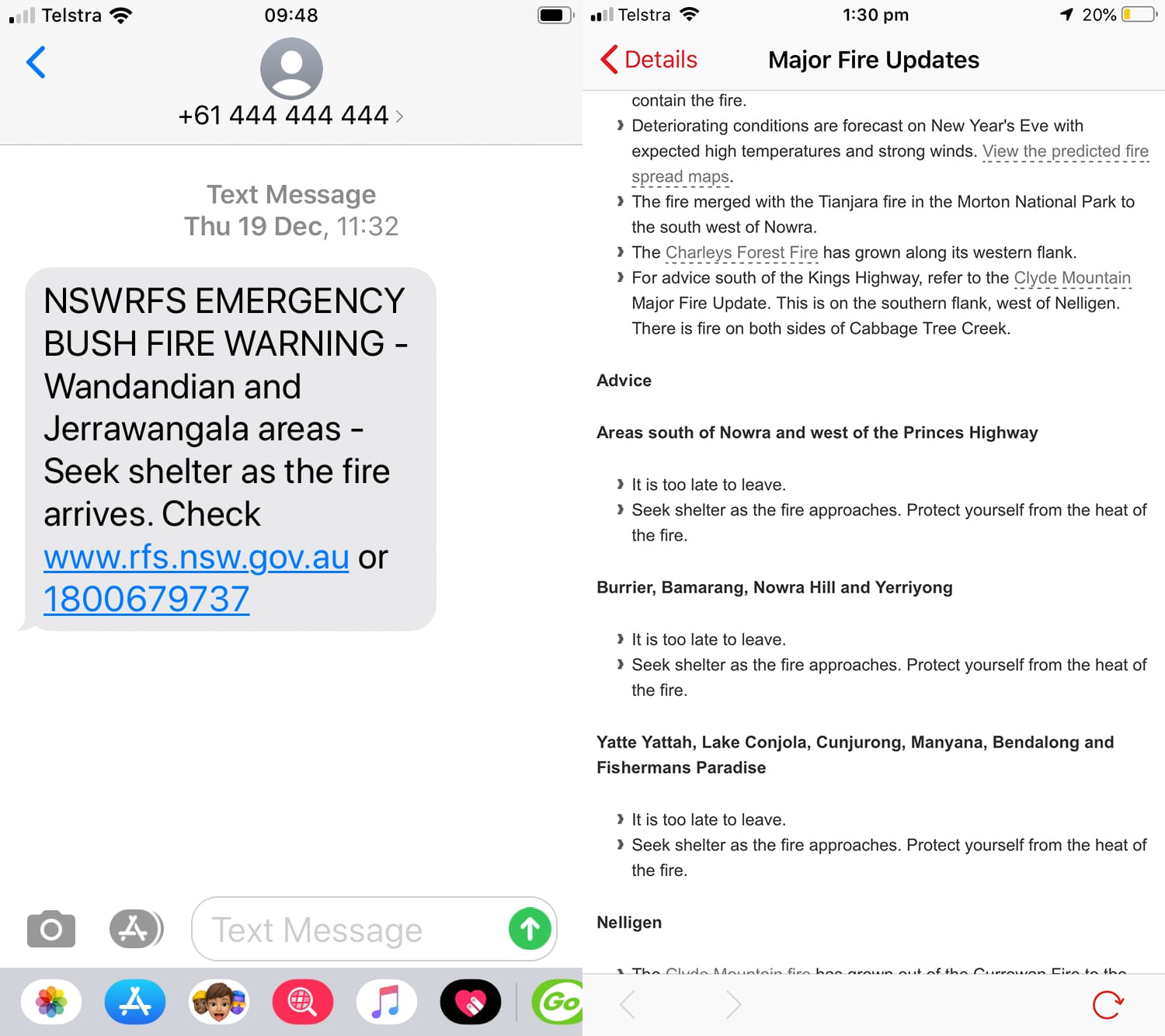
An example of the kind of texts that fire out automatically to all phones in the radius. The most sobering are those that begin with ‘Too late to leave.’ Major fire updates are also posted online, with the Manyana/Bendalong area listed as ‘Too Late to Leave’ on NYE.
I have spent many wonderful extended holidays in Australia since my elder brother, Mark, moved there over 30 years ago. My trip for Christmas 2019 was already long planned and booked when the season’s first bushfires began in Queensland and northern NSW (where my niece is a park ranger) and naturally I had my concerns for all affected, especially as the fires seemed earlier and fiercer than usual.
My brother lives in the heart of Sydney, with the added blessing of a modest bungalow in Manyana/Bendalong, three hours down the south coast. As bushfires are a regular occurrence of the continent’s summers (I’ve heard its oil-rich eucalyptus trees described as ‘arboreal petrol bombs’) I kept only a watchful, distant eye with no sense that I should reconsider my plans.
That still, small voice…
In November, things grew worse as the ‘fire season’ spread southwards. Then, Green Wattle Creek to the south west of Sydney went up in flames and the Blue Mountains inland of the conurbation began to smoulder and spark, the eventual inferno ripping through several idyllic highland towns. Dry lightning and ten years of drought was now wreaking a terrible revenge that even cosseted city dwellers could not ignore.
Sydney — that bold and beautiful symbol of a successful, urban Australia, began to choke on the dense, lingering, smoke borne by a hot, westerly wind. Even so, I kept a steady course. I have experienced low-level smoke in the Sydney basin before. Unpleasant as it can be (and frightening the first time you are woken by it) it tends to lift fairly quickly with a weather change and a fresh sea breeze — and is not especially worrying unless you suffer from a respiratory or heart condition. Nevertheless, better to keep the little ones and the elderly indoors and not exert yourself.
“It will be ok,” I said to myself, “get on the plane. Don’t be a wuss.”
Yet, somewhere deep within, another small voice was whispering for my attention, to prepare me, perhaps. I might have listened but I dismissed it as my tendency to worry too much. I might have reconsidered how much of this I wanted to witness, but in a recent meditation retreat our teacher stressed that this was not about escapism. That in life — and in troubled times especially — it remained important to ‘turn towards’ and not turn away. I certainly wasn’t going to turn away from my family.
Sydney Blues (under not-so-blue skies)
My first day there wasn’t so bad. I seemed to have carried south a few clouds, a droplet or two of rain and some fresher air. I wasn’t conscious of any unusual smoke or smell. All cities, especially near airports, have that vague scent of combustion, even if it’s the result of burning fossil fuels rather than forests. (Perhaps, we are no longer as alarmed by such a persistent aroma as we should be?)
The next day in Sydney’s Surry Hills was lovely, but there was something very strange about the light. It glittered yellow-orange on anything glass or metal and a pale pink sun cast a peachy glow over the city’s stone. It was eerily beautiful, yet came with a keen awareness that such ethereal diffusion is not the way the light ought to look on a healthy planet. (On Caprica perhaps, yes, for Galactica fans.)
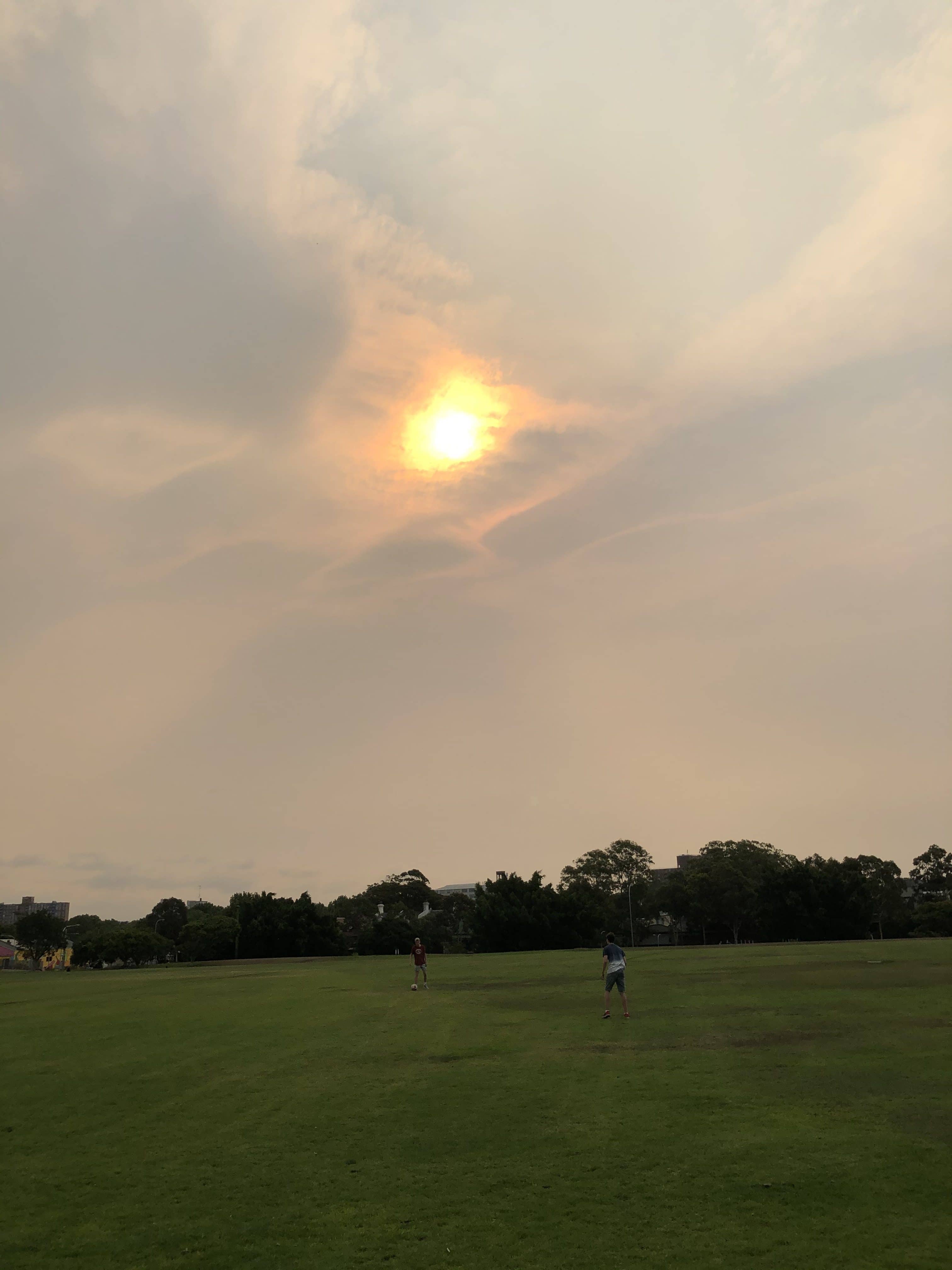
An eerie atmosphere over Sydney’s suburbs. Picture: Author’s own.
For the next week or so in Sydney despite a persistent high haze and occasional, cough-inducing, lower-level smoke, it felt fairly safe, even if the city was experiencing a very different ‘atmosphere’ both physical and emotional. Few surfaces could be touched without picking up a fine coating of ash and window sills and outdoor furniture were positively crusty with it. Yet there was still much to enjoy and look forward to.
One road in, one road out
Traditionally, just after Christmas we all head south to where my family have a treasured retreat on a beautiful, beach-fringed headland. Largely un-spoilt and laid-back, their quiet little community is surrounded by national parks and native bush, but with only one road in or out from the coastal highway.
Considering the current conditions, we had been playing it by ear, but the Aussies are tough and stoic by nature, used to bushfires (though rarely anything of this scale or severity) and rightly trusting of official advice as to any immediate danger. Our holiday neighbourhood was under the “Watch and Act” advisory, with three fires to keep an eye on, but no direct threat… as yet.
Friends who live there permanently had assured us that preventative back-burning (which had closed the main highway on Boxing Day) seemed successful and weather and wind conditions were currently fair, so, as there was essential work to prepare the house in case danger did approach, we all drove down. But as we got closer every intuitive alarm bell and red light went off in the primal centres of my brain.
Mordor Rising
We arrived by night and from the highway on the other side of the headland we could see the orange glow of flames and billows of dark smoke in the Jerrawangala national park. When we got to the house the acrid smell and sting of wood smoke assailed my senses and I knew we should not stay there long.
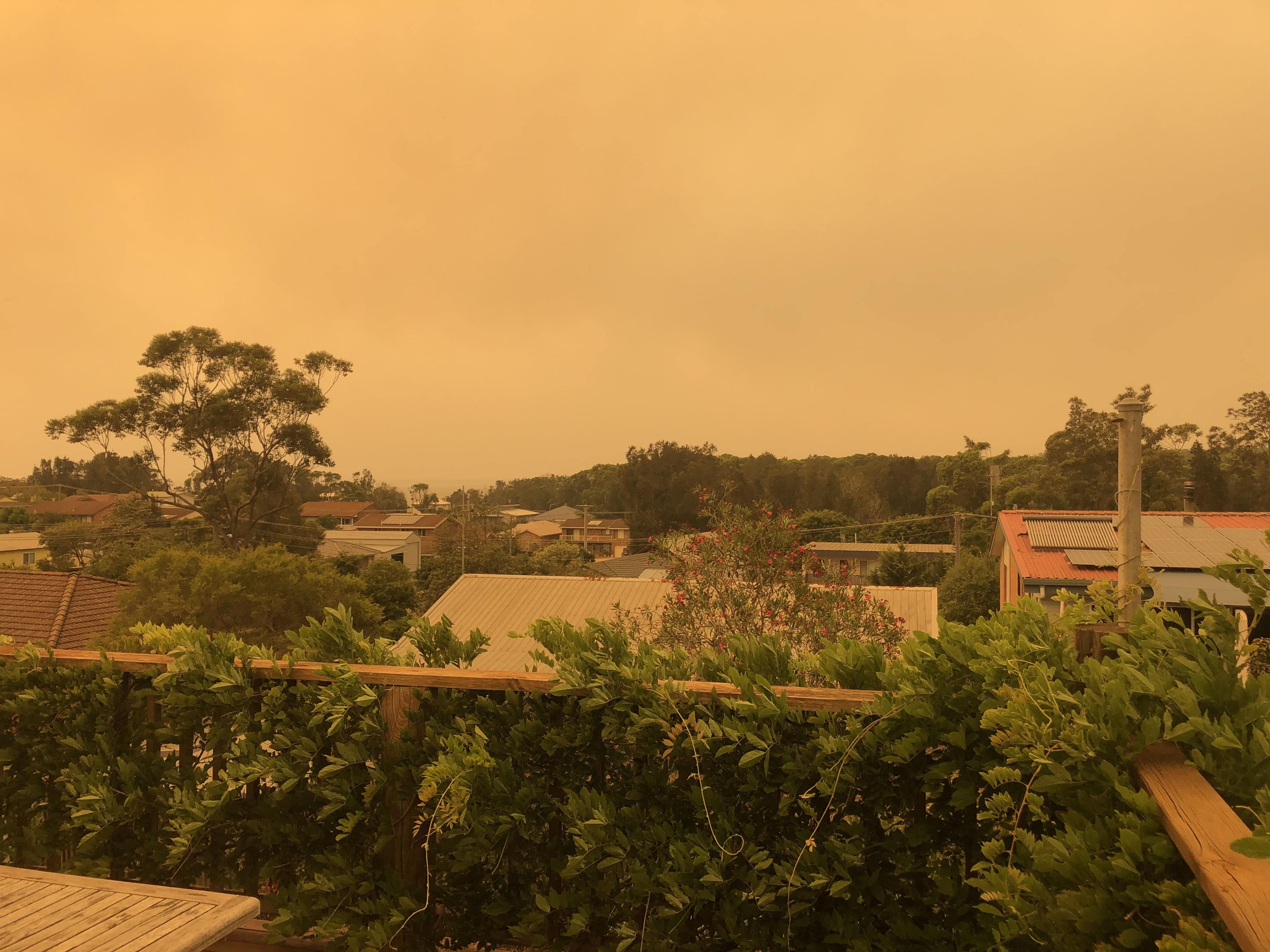
‘No filter.’ Brown skies envelope Manyana with the sting of bushsmoke in the air. Picture: Author’s own.
I’m a great believer in rational analysis, critical thinking and weighing all the evidence, in listening to experience and expertise — but I also believe in instinct and heeding your gut. I find it curious that people often ask if the Eloise character in Bone Lines, the ruminative scientist in the contemporary narrative, is based on me but rarely ask whether ‘Sarah’, the intuitive prehistoric survivor is too — and yet I created both. In truth I think there’s a little of me in each.
Thus, in ‘Eloise’ mode, I spent much of the next morning examining all the ‘fires near me’ maps and predictions (and it’s not only the fire front you have to watch for, but wider areas of potential ‘ember attack’) together with all the latest weather and wind direction forecasts, the patterns and timings of highway closures, etc. If any one of those three fires grew bigger or came closer, or heaven forbid, joined up, we could be in trouble. My family were not taking the situation lightly and were prepared for various eventualities, including a well-equipped evacuation if need be.
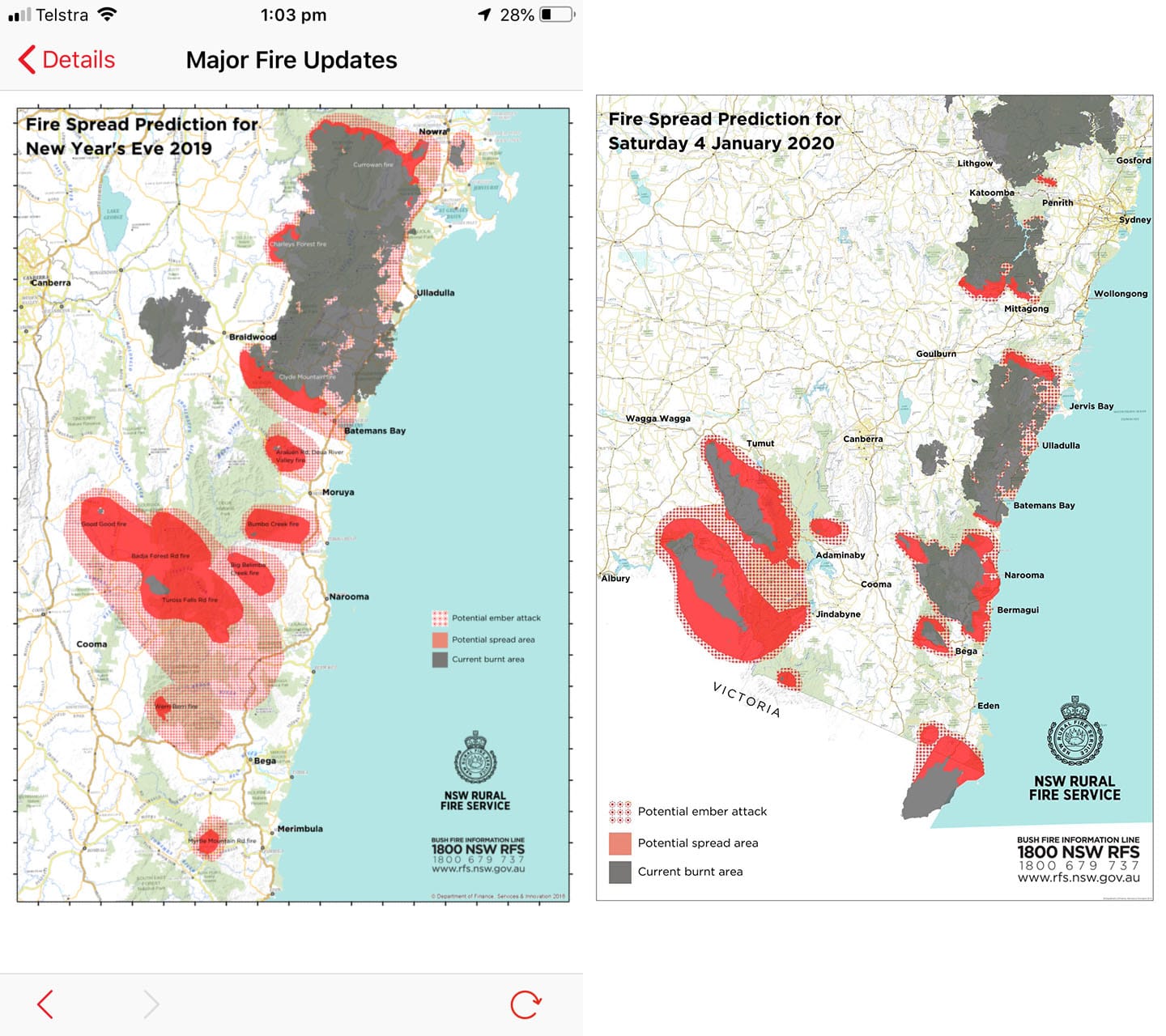
I spent much time looking at these sites and apps! Right was the prediction for NYE, Manyana was still just outside the fire spread zone to the north of Ulladulla, but ‘too late to leave’ as the Princes highway was closed. Right: January 4th was the worst day for Manyana, which is between Ulladulla and Jervis Bay. The Fire reached the back of the first row of houses in the hamlet.
The weather improved considerably during the day, however, with fresh breezes off the ocean blowing away most of the smoke and we were able to enjoy a lovely walk and swim — although, on emerging from the crystalline water we had to wade through a sticky wash of cinders and burnt leaves mixed in with the sea-foam. As we left the beach, the weather began to change once more and a dark glowering was rising in the distance, like something out of Lord of the Rings on the dreadful approach to Mordor.

The approach to Mordor … or one of the weirdest beach walks I have ever taken! (Frodo might have been telling me something?) Picture: Linda Garry Bretherton
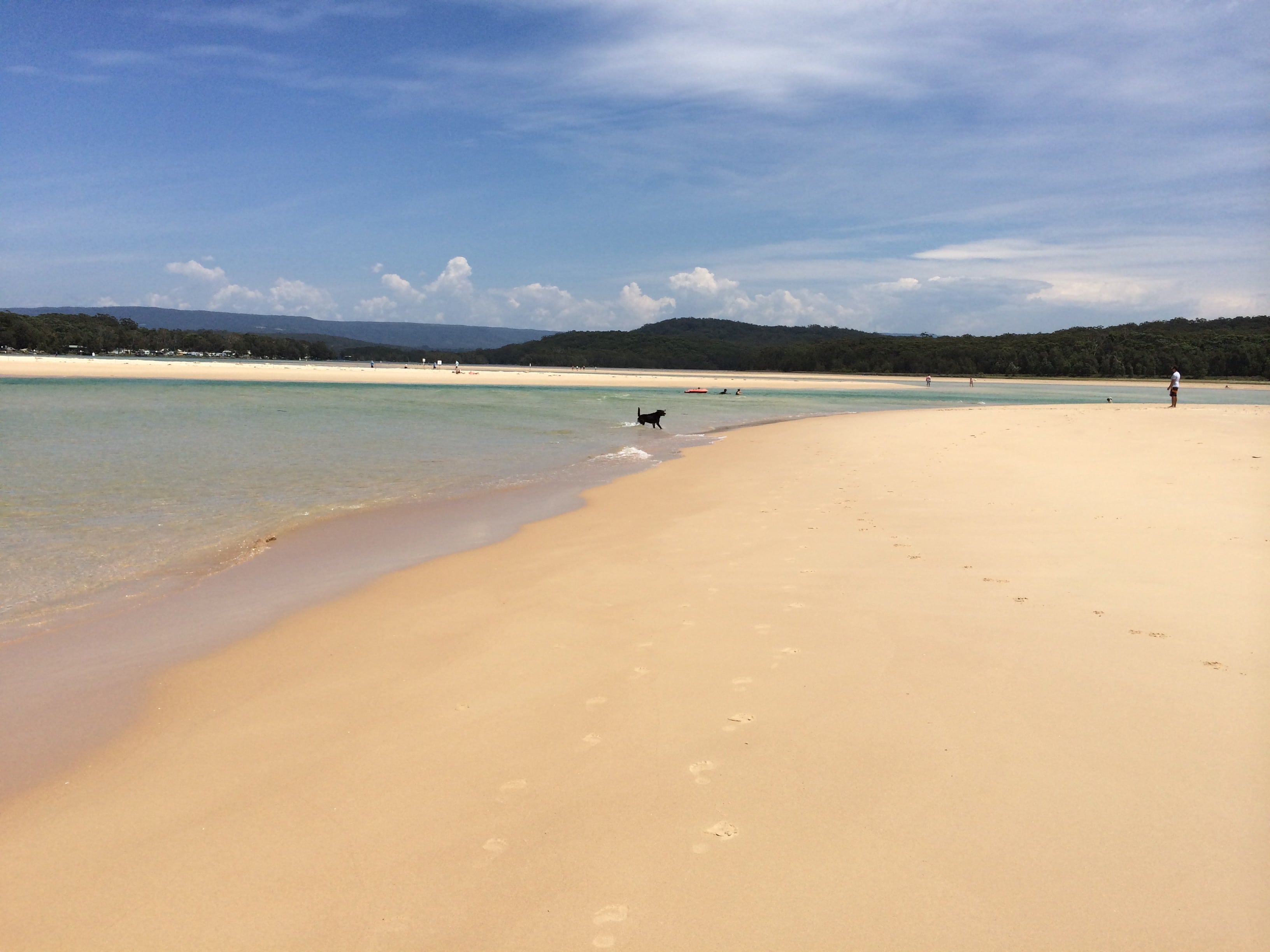
How the beach is supposed to look rather than something out of Lord of the Rings!
Sense and Sensibility
I had a sense that more smoke would drift down in the night, so I closed the window and door to my bedroom while the others preferred a flow through of cool sea breezes. The next morning I opened my door and the smell of burnt forest had filled the house. My ‘flight’ response had now fully kicked in. I asked my family whether the next day — if they still wanted to stay — they would drive me 45 mins to the nearest railway station, so I could hop on a train back to Sydney.
I think by then, however, my beloved and generous hosts were inclined to indulge both my obsessive analysis of all available info — and my gut feelings, particularly fears about potentially getting trapped and missing my flight out. So, by consensus we headed back that afternoon while the highway was open and traffic still manageable, driving through occasional mists of smoke and leaving behind an angry red sun in a dirty brown sky — and thank heaven we did.
Two days later, on New Year’s Eve, ferocious conditions flared up and every danger combined to make life hell for both residents and any holiday makers still in the area. Three fires merged, hot winds fanned the flames, the highway was closed in both directions along our section, power and phone signals went down.
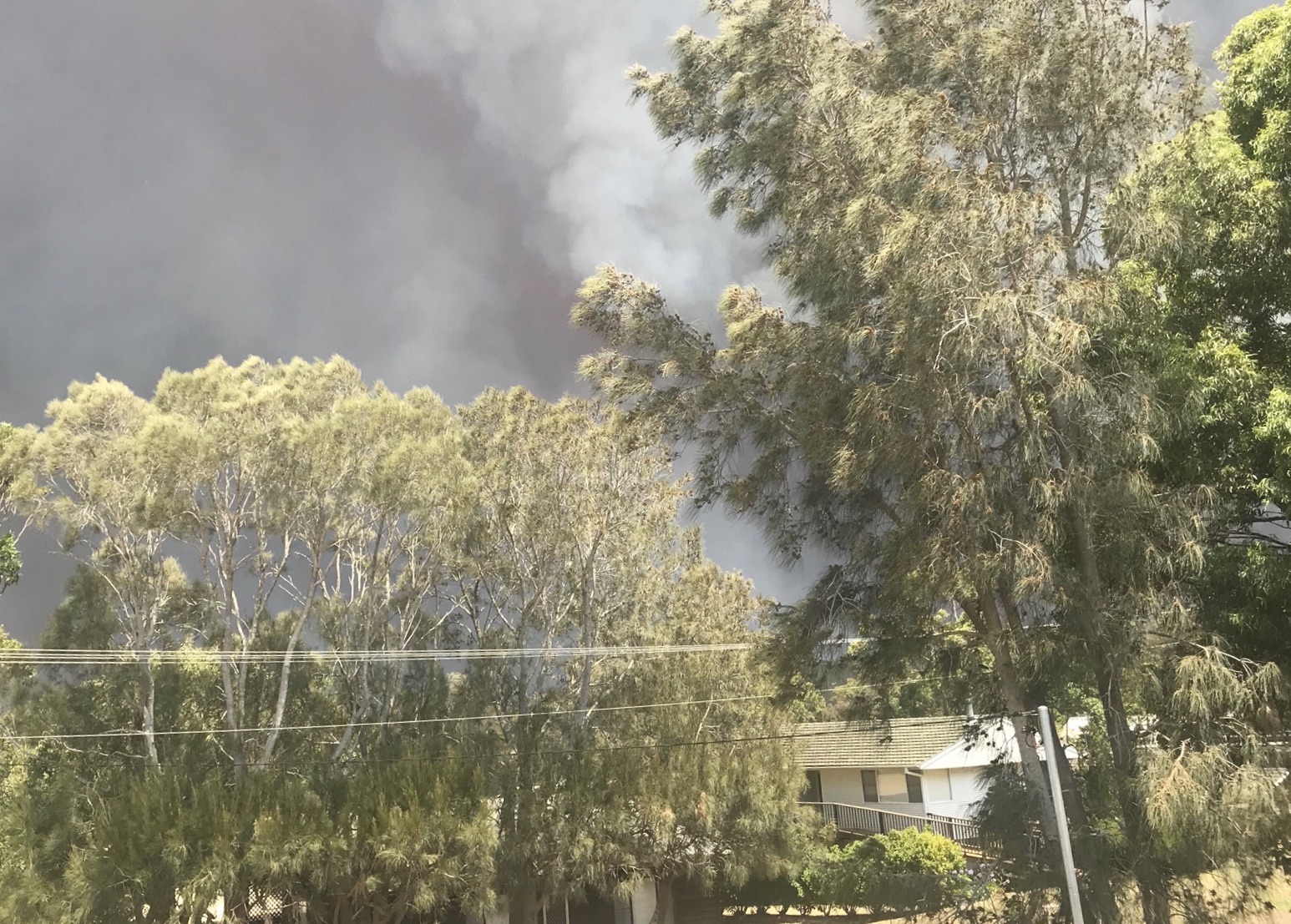
Fire comes closer on NYE. My family’s white bungalow is bottom right – taken from the deck of my sister-in-law’s cousin’s place – he just missed the window we took while the highway was open and although he tried to leave another day, the road was too dangerous and he had to stay until an escorted evacuation a few days later. (Picture courtesy of ‘Cousin Des’)
Watching and Waiting
We spent the next few days back in Sydney madly scanning all forms of media and trying to get word to and from friends and extended family still in the hamlet (including encouragement to salvage fresh supplies from our melting freezer, etc.) Some had simply not expected it to get that bad, that quickly, others had made the decision to stay anyway to defend their homes, something which can be done successfully in the right conditions and with the right equipment and techniques.
Evacuation plans if such defensive action failed included heading to the beach, sure of covering up in long cotton layers, taking towels and blankets to protect from wind-blown embers and fiery twigs, carrying water, torches and emergency rations. We were so thankful we had left, but so worried about those left behind — and for the glorious surrounding habitat with its precious wildlife, already suffering after a decade of all the heat and drought of climate-breakdown.
There was something surreal about the situation, however. Watching helplessly, I couldn’t help thinking, surely it can’t get any worse, surely it can’t be this bad, something, someone has to stop it? But while containment by the heroic ‘Firies’ can (if all goes well) protect human habitations, a bushfire only stops when it runs out of fuel or reaches a big enough fire break in favourable winds — or if it rains heavily. No meaningful rain was forecast until mid to late January.
Critical Thinking
The post-mortems were already underway in pub conversations, at dinner tables and in certain media… why had the Federal Government not heeded its own report from 11 years ago — and the warnings from Fire Chiefs earlier this year? Why had both Federal and State authorities not been better prepared?
Why had ‘modern’ Australia not learned more about indigenous land management, not had more respect for that ancient wisdom? Why were certain wealthy news corporations playing down the problem, still denying the ‘carbon connection’? Why were the country’s supposed ‘leaders’ and key ministers not conspicuous, sleeves rolled up at ground zero, supporting their people, rather than holidaying overseas?
Ultimately, you get your head around the fact that it really is ‘that bad.’ And conditions in ‘our’ little corner of that unique continent went from bad to worse. Fire had now spread along the only road in or out of the Bendalong headland. What food people had stocked was running out, or going bad in fridges forced into an unwelcome defrost by the power cut. It was hot, smoky, fearful and for some stuck on their own, terrifyingly lonely.
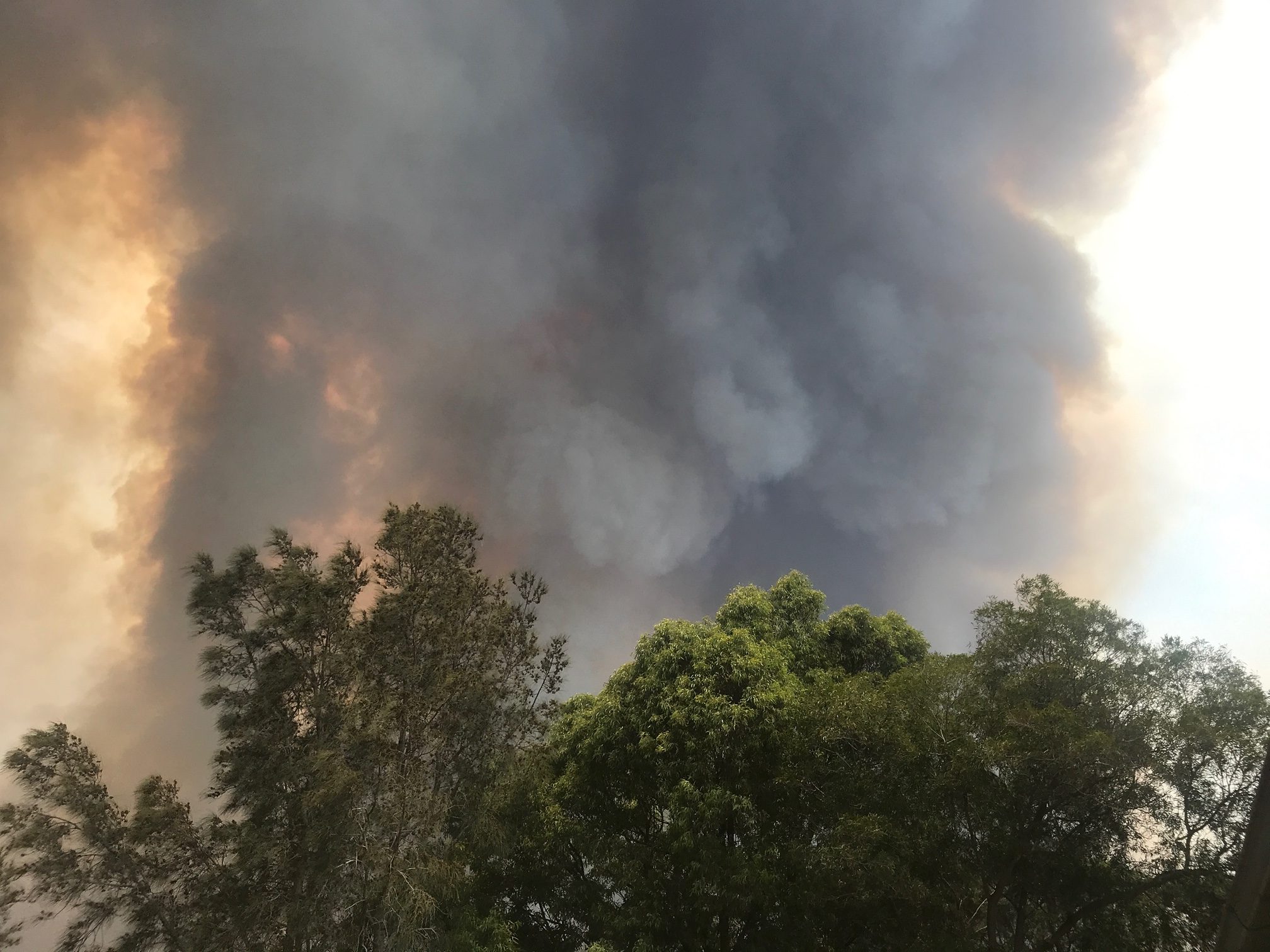
The fires near Manyana get way too close for comfort. (Picture courtesy of ‘Cousin Des’)
The Kindness of Strangers
The Aussie ‘can-do’ spirit went into high gear, however, and people made the best of a dire situation, pooling resources, sharing info, coming together to support and help each other. Only after she got out a few days later did we hear the tale of one friend who, because fresh food was running low, took a chance and drove into the nearest town on NYE only to be stranded there when the highway closed behind her due to essential containment activity.
Cut adrift from her family, she knocked on the door of a random house and was taken in (ah, the kindness of strangers.) But she didn’t want to spend the night away from her kids, so being particularly athletic/brave (in ways I could not contemplate) she decided to hike back home the long, hard way, along the coastline! She clambered over rocks, swam across a creek (kindly watched over by a surfer, with whom she left her handbag for safekeeping) and walked the various beaches until she reached home.
By New Year’s Day, at least the fires were still being held back from the hamlets on the headland by more helpful weather conditions (although tragically, 80 homes were lost across the lake entrance that borders the headland, in neighbouring Conjola Park) and there was a very brief respite before another high-danger weather event. Under careful supervision, most of those who wished to leave were then escorted out by emergency services, one by one, weaving past fallen trees and power lines out to the re-opened highway — though many had to queue for hours to get out by the 5pm deadline.
At the whim of the wind
Just as well. The following day brought terrible conditions raging up from South Australia, through Victoria and along the south coast of NSW, threatening so many communities, including ours. Those permanent residents who had decided to ‘defend’ set up an emergency camp on the beach to evacuate to if needed.
We crossed our fingers, hoped and prayed, refreshed the fire apps to watch its front creep ever closer on the map. And closer it came. Miraculously, however, the inferno ravaged the bush right up to the back yards of the first row of houses in Manyana (one street away from my brother’s) before being beaten back by the extraordinary, largely volunteer Rural Fire Service — and a timely southerly wind change.

Fire burned right up to the first back yards, one street away from my family’s home. No homes were lost in Manyana due to the heroic ‘Firies’ and a favourable wind change (Picture courtesy of Vincent of Curvers Drive)
Yet, what saves one community devastates another. It’s hard to feel guilt-free relief when so much destruction was delivered elsewhere by the same wind that was Manyana’s saving grace. (A tiny hamlet that made international news. Admittedly, we had a certain frisson of mixed feelings in seeing our little neighbourhood’s dilemma written up in The Guardian.
One heck of a wake-up call
Indeed, the whole world has been watching these dramatic, tragic events, even if the scale of the fires affecting Australia this year is difficult to comprehend. (If you are from the UK, try to imagine all the land between London and Birmingham, ablaze.) And even though my nagging nervousness meant that my family watched the worst of it (so far) from a relatively safe distance, I feel as though I’ve just had front seats for the first act of the apocalypse.
Yet I have been a mere bewildered bystander. My no-nonsense niece, Holly, who works for the Forestry Commission in NSW and is at the ‘coalface’ of the crisis (so to speak — a deliberate expression considering the Morrison government’s cosy relationship with such a ‘dirty’ industry) has little time for all the ‘hysteria’ and the ‘saturation of unqualified commentary,’ none of which she finds useful, or realistic.
And fair enough, as she is there on the ground, working 14 hour days (making European newspapers), taking action, getting her hands dirty, finding the positives and looking to see what can be learned, rather than indulging in any tearing of hair and gnashing of teeth. (Or enjoying 15 minutes of fame on social media by giving a parched Koala a sip from a plastic water bottle – a species not helped, she feels, by questionable claims that it is now ‘functionally extinct.’)
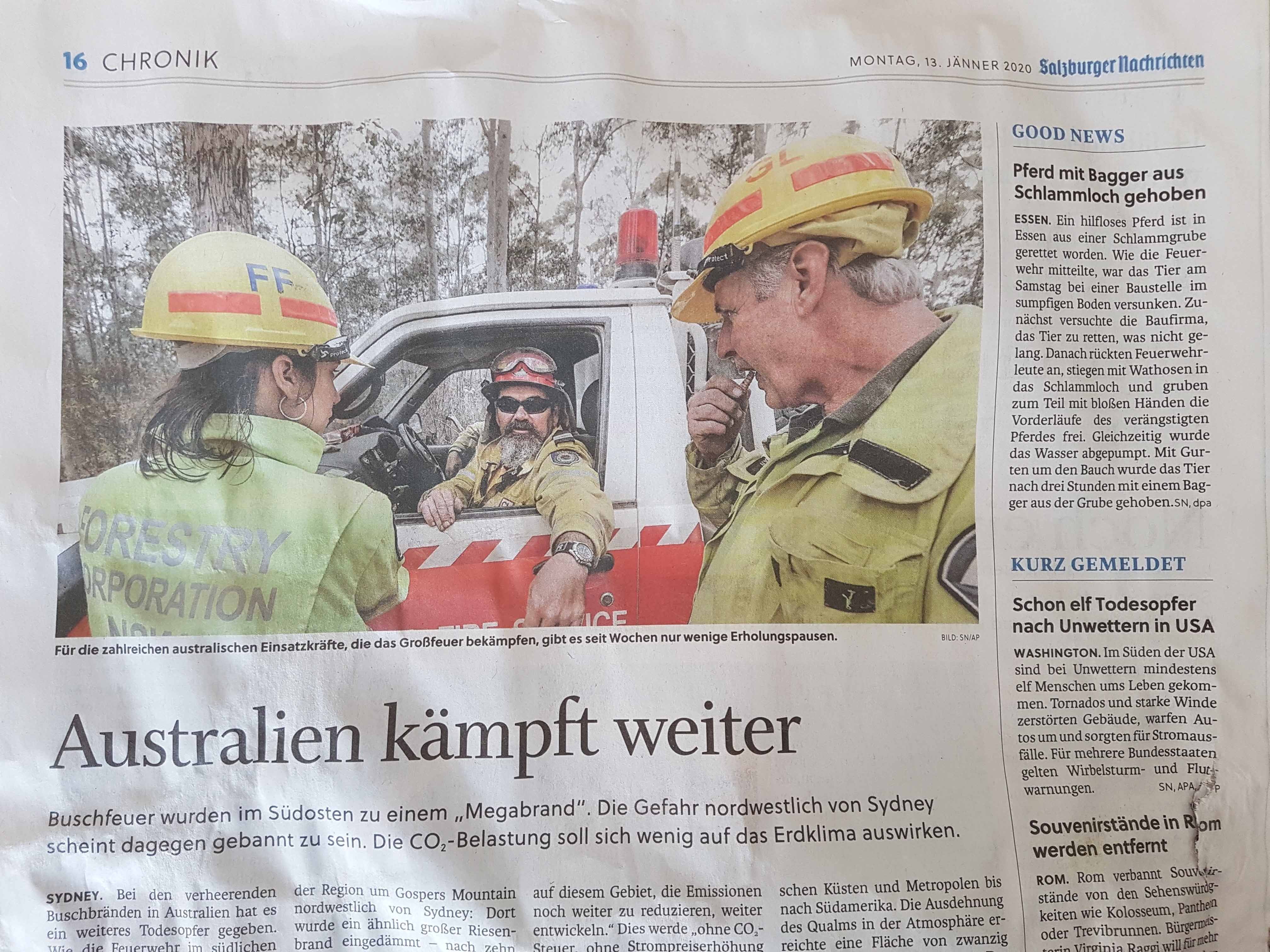
My niece, Holly, makes the international news (clearly, the one with pony tail talking to a ZZ Top doppleganger.)
But don’t we all need to see what can be learned? As I flew out from Sydney — with some relief, I do have to say — I walked past all the duty free shops and the memorabilia stalls and thought, “the only souvenir I’m bringing back is a lungful of former Australian bush.” And well deserved perhaps?
Although it is my only major flight these days, nevertheless the ‘love miles’ I burn to see all that’s left of my nuclear family, a semi-circle of the world away, probably only adds to the problem. My justification has always been that not eating red meat for forty years may have offset some of my carbon footprint, but maybe both my family and aviation’s greenhouse gases need a break from me next year?
And while some have knowingly trashed ecosystems for profit, perhaps many more of us are guilty simply of living too well and, quite literally, loving our world and all its treasures and pleasures to death? For the greater percentage, of course, for whom life is a matter of either subsistence or survival, their struggles will only increase as more of the planet becomes uninhabitable.
Reflection, Remorse… Renewal?
My first few days out of Australia I found myself often overwhelmed by sadness, unable to hold back the tears. I kept imagining the local kangaroo mobs that hop through Manyana’s gardens, now hungry, thirsty and displaced (those that had survived.) The native bush has evolved to regenerate, but many fear a deep cost to diversity and species on the brink by this level of loss.
Another great joy of my Manyana visits has been feeding the cacophonous and colourful wild birds that flock to the deck for a handful of birdseed. How much more would they need that birdseed now, if they had not died of exhaustion by flying too far out to sea to escape the fire?

A flock of lorikeets enjoying birdseed on the deck at Manyana and a local roo family, both in better days.
When I can risk the remorse, I also think of the heartbreak and rage those original peoples of the continent must be feeling — though perhaps they have greater reserves, more experience of loss, deeper knowledge to draw upon than we usurpers? And as my niece also insists, it’s their voices that need to be centred in the conversation now (and which deserve more space than can be served by an obscure blog post such as this.)
Nevertheless, for so many of us, the ‘eco-grief,’ can be hard to bear. But bear it we must. For me it has become a constant background hum — and occasionally a wailing siren.
Yet small things lift the spirits. My sister-in-law was delighted when the single hibiscus flower that greeted her return to Manyana (a favourite kangaroo delicacy) had been eaten the following day. Previously, she might have wished to enjoy the bloom a little longer, but its overnight disappearance now seemed a welcome sign of hope.

A fuzzy but uplifting sight. A hibiscus-loving roo hops past the front of my family’s home, a couple of weeks after the worst of the fires.
There have been so many stories of hope, bravery and kindness, even among the animals, if the apocryphal tales of ‘heroic’ wombats sharing their burrows with forest refugees are to be believed. Perhaps we all need to attempt some kind heroism, even if that starts with acknowledging our own hypocrisies and working to resolve our moral/practical conflicts? In accepting the parts we’ve played, consciously or unconsciously, and making whatever changes we can?
While it may be “too late to leave”, perhaps by listening deeply – by turning towards – we may yet see a few blooms of regeneration and explore new ways of being? One can only “watch and act.”
Donate
If you would like to help out with the crisis in Australia there are many organisations that you could search and donate to but here are just a few suggestions:
JOIN STEPHANIE’S MAILING LIST
And all subscribers will receive news, blog updates and subscriber-only specials. So please sign up. It only takes a couple of clicks and you can unsubscribe at any time…
